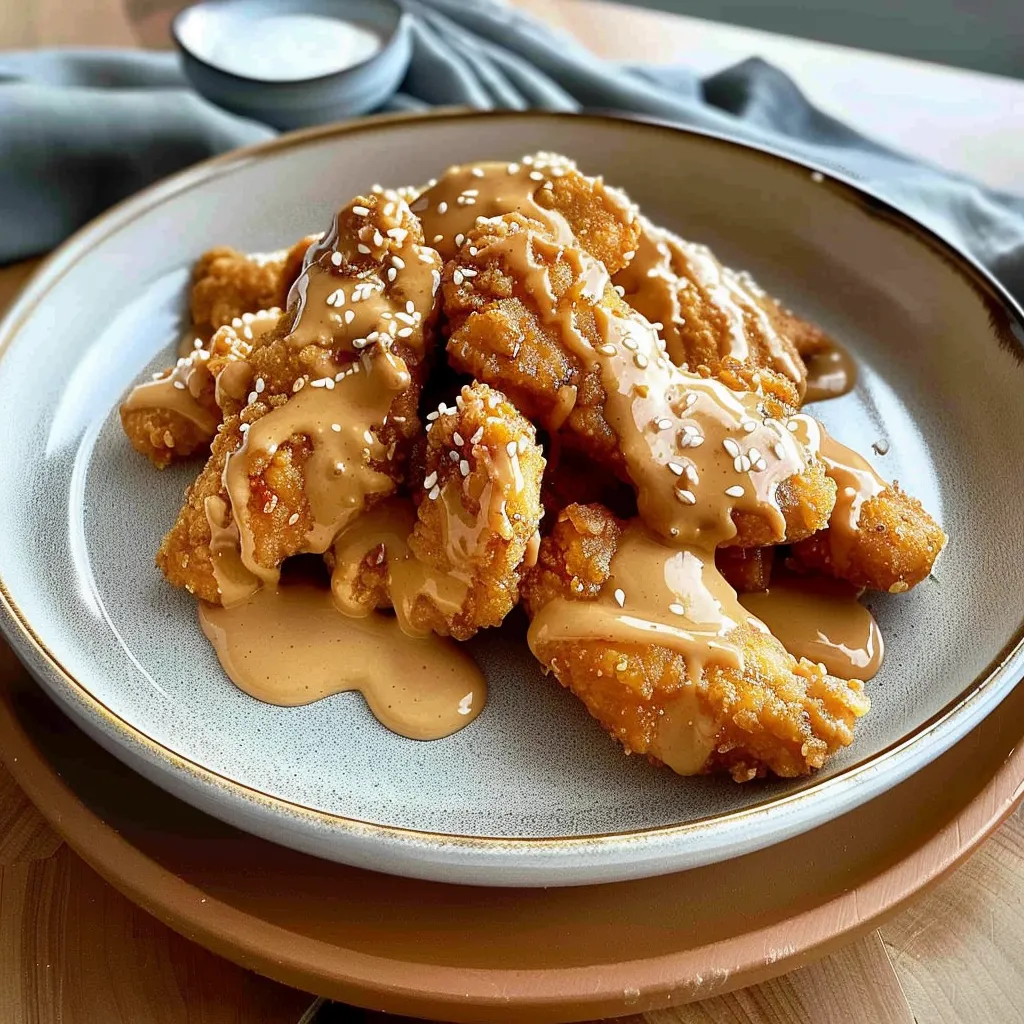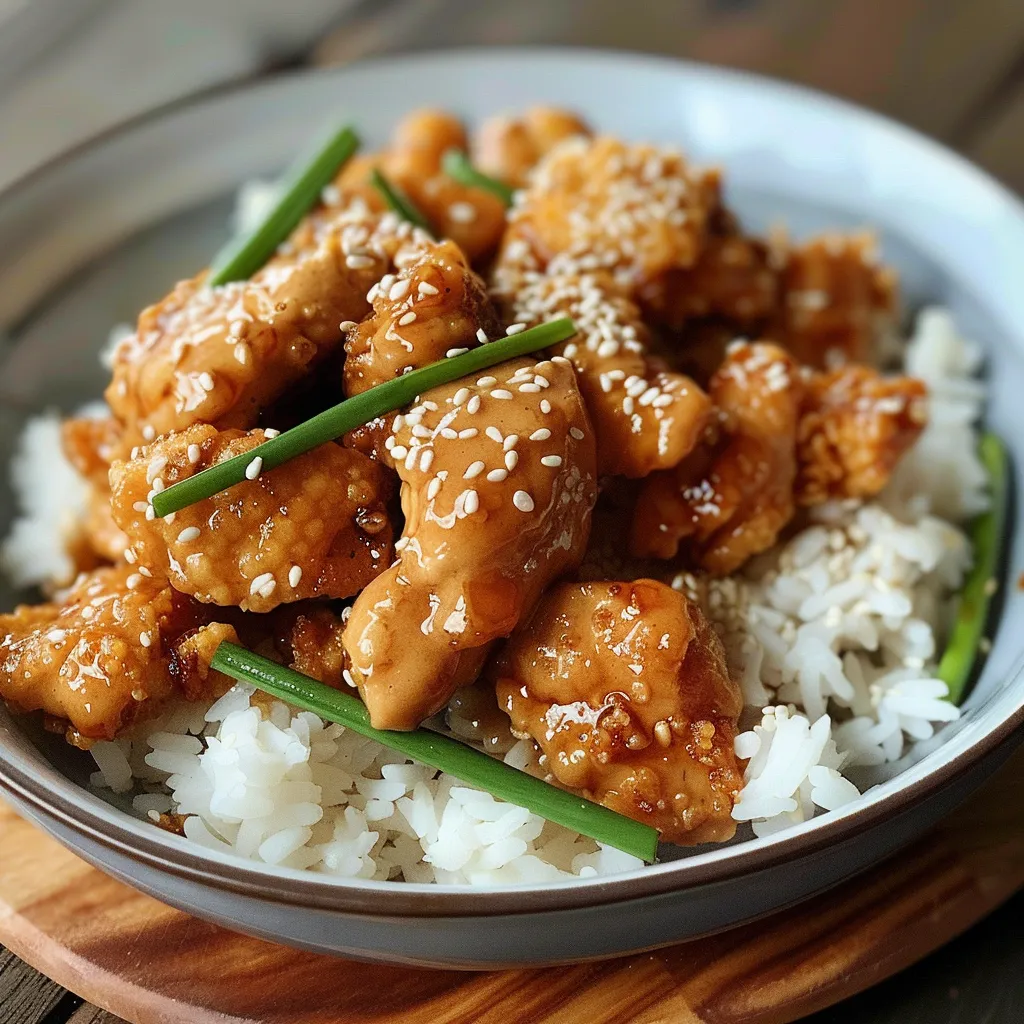 Bookmark
Bookmark
This Chinese peanut butter chicken recipe transforms ordinary chicken into an irresistible dish with a creamy, savory sauce that perfectly balances sweet and spicy notes. The combination of peanut butter, soy sauce, and honey creates a velvety coating for tender chicken pieces that will have everyone asking for seconds.
I discovered this recipe during my culinary exploration of Asian fusion dishes and it quickly became my go-to when entertaining guests. The first time I made it for my family, my daughter declared it her new favorite meal and now requests it at least twice a month.
Ingredients
- Boneless chicken thighs or breasts choose thighs for more flavor and tenderness as they stay juicier than breast meat
- Creamy peanut butter forms the base of our velvety sauce providing richness and body
- Soy sauce adds that essential umami flavor and balances the sweetness
- Honey brings natural sweetness that caramelizes slightly when cooked
- Rice vinegar adds brightness and cuts through the richness of the peanut butter
- Sesame oil provides that authentic nutty aroma that elevates the dish
- Fresh garlic and ginger aromatic foundations that create depth of flavor
- Red pepper flakes adjust the amount based on your heat preference
- Chicken broth thins the sauce to the perfect consistency
- Cornstarch optional thickening agent if you prefer a more substantial sauce
- Green onions and peanuts fresh garnishes that add texture and visual appeal
Step-by-Step Instructions
- Prepare the Chicken
- Cut chicken into uniform bitesize pieces about 1 to 1.5 inches to ensure even cooking. Season generously with salt and pepper on all sides making sure each piece gets proper seasoning.
- Create the Foundation
- Heat vegetable oil in a large skillet until it shimmers but doesnt smoke. Add chicken pieces in a single layer without overcrowding the pan. Allow them to develop a golden crust by resisting the urge to stir for 4 5 minutes. This browning process creates flavor compounds that will enhance the entire dish.
- Build the Aromatic Base
- After removing cooked chicken lower the heat to prevent burning the aromatics. Add minced garlic and grated ginger to the pan and stir constantly for about 30 seconds. The fragrance should bloom but not brown which would create bitterness.
- Create the Sauce
- Add peanut butter to the aromatic base and stir constantly to prevent scorching. The heat will melt the peanut butter creating a smooth base. Gradually incorporate soy sauce honey rice vinegar and sesame oil stirring continuously to create a homogeneous mixture.
- Perfect the Consistency
- Slowly add chicken broth while stirring to achieve your desired sauce thickness. The sauce will initially look separated but will become glossy and uniform as you continue to stir and heat it. For a thicker sauce prepare a cornstarch slurry and add it gradually while the sauce simmers.
- Bring It All Together
- Return the browned chicken to the pan including any accumulated juices. Gently fold the chicken into the sauce ensuring each piece is well coated. Allow everything to simmer together for 2 3 minutes which helps the flavors meld and ensures the chicken is completely cooked through.
 Bookmark
Bookmark
The secret ingredient that makes this dish special is fresh ginger. I remember once trying to make this without it when I ran out, and the difference was remarkable. My husband immediately noticed something was missing. Now I keep frozen ginger cubes on hand so I'm never without this essential flavor component.
Make It Ahead
This dish actually improves with time as the flavors continue to develop. You can prepare the entire dish up to two days in advance and store it in an airtight container in the refrigerator. When reheating, add a splash of chicken broth or water to loosen the sauce, as the peanut butter will thicken considerably when chilled. Gentle warming on the stovetop works better than microwave reheating, which can make the chicken tough.
Perfect Pairings
While traditional white rice makes an excellent base for this saucy dish, consider trying it with coconut rice for an extra layer of flavor. The subtle sweetness of coconut complements the nutty peanut sauce beautifully. For a lower-carb option, serve over cauliflower rice or zucchini noodles. Add a side of steamed broccoli or sugar snap peas to balance the richness of the sauce with fresh vegetables.
Cultural Inspiration
This recipe represents a wonderful fusion of Chinese cooking techniques with American ingredients. Traditional Chinese cuisine often features sesame paste in sauces, but peanut butter creates a similar effect with ingredients more commonly found in Western pantries. This adaptation emerged during the mid-20th century as Chinese-American cuisine evolved to incorporate locally available ingredients while maintaining authentic cooking methods and flavor profiles.
Dietary Modifications
This versatile recipe easily adapts to various dietary needs. For a dairy-free version, you're already set. To make it vegan, substitute the chicken with extra-firm tofu, pressed and cubed, or use seitan for a meaty texture. For those watching carbs, serve over cauliflower rice or alongside a fresh Asian slaw. If you're avoiding added sugars, replace the honey with a monk fruit sweetener or simply reduce the amount.
Recipe FAQs
- → Can I use chunky peanut butter instead of creamy?
Yes, chunky peanut butter can be substituted for creamy, which will add extra texture to your sauce. You might need to add a bit more chicken broth to achieve the desired consistency as chunky peanut butter tends to make a thicker sauce.
- → How can I make this dish less spicy?
To reduce the spiciness, simply decrease the amount of red pepper flakes or omit them entirely. The dish will still be flavorful from the garlic, ginger, and other ingredients without the heat.
- → Can I use chicken breast instead of thighs?
Absolutely! The recipe already mentions you can use either chicken thighs or breasts. Just be careful not to overcook the breast meat as it tends to dry out more quickly than thighs. Aim for just cooked through to maintain juiciness.
- → What can I substitute for sesame oil?
If you don't have sesame oil, you can use additional vegetable oil, though you'll lose some of the distinctive nutty flavor. For a closer substitute, try peanut oil or a neutral oil with a few drops of toasted sesame seeds ground up and added to the sauce.
- → Is this dish gluten-free?
Not as written, since traditional soy sauce contains gluten. However, you can easily make it gluten-free by substituting tamari or certified gluten-free soy sauce and ensuring your cornstarch is from a gluten-free source.
- → Can I prepare this dish ahead of time?
Yes, this chicken dish reheats well. Store it in an airtight container in the refrigerator for up to 3 days. When reheating, you may need to add a splash of water or chicken broth as the sauce tends to thicken when cooled.
